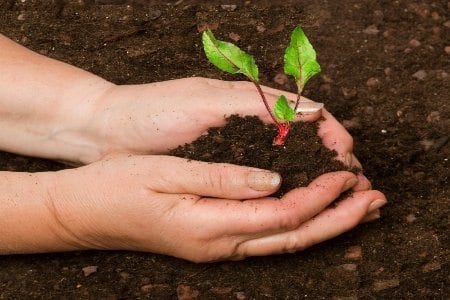TRANSPLANTING

Transplanting for the gardener means moving a plant from one location to another. In the springtime many of us germinate seeds to be planted outdoors. As they germinate and grow we need to transplant them into larger containers and give them more room. When starting seedlings indoors, good light is essential. Light is a growth inhibitor which slows down the growing process. Crowded seedlings shade light from each other and seedlings become thin and strangely. Transplanting is essential allowing a plant more light and space to grow. As the weather becomes warm enough and the plants become big enough, we need to harden them off and transplant them into the garden. Transplanting is essential in growing a strong healthy plant.
Houseplants continue to grow and as they become root bound and too big for their pots, they need to be transplanted. A plant that has become root bound needs to have its roots sliced by running a knife down the side of the root ball in 5-6 longitudinal cuts to stimulate rooting.
Plants being sold in today’s market are grown in containers and often become root bound. The same slicing procedure is required before planting it into your yard. Prior to transplanting, a plant should be well watered. When planting outdoors, always makes sure your soil is properly prepared. Follow the directions in my book 12 Steps To Natural Gardening. Always add Myke to the roots of the plants. Myke is a combination of microbes including Mycorrizal fungi Micorrizal fungi is of particular importance to us for it forms a symbiotic relationship with roots, promoting a deeper and stronger root system.
In the spring it is a good time to evaluate your perennial beds. Many plants that have become too big need dividing and the other sections transplanted to another location on your property. You may determine some plants are in the wrong location and you need to move them to a better one. Always look at your perennial beds and determine what needs to be transplanted. Transplanting is what makes a perennial garden look great.
Transplanting is something we often never think about until it is too late. It is one of the great tools we have at our disposal. It is a judgment call that we need to make. A garden is not carved in stone. As things grow, changes occur. Often these changes are for the good, but sometimes they are not and corrections need to be made.
Before a plant gets too big for its location and while it can still be transplanted, moving it to a new and better location is a good option. Evaluate your foundation planting and if something has become too big for its location, think of transplanting it. Many times it can become a valuable plant in your border planting, creating privacy for your property. These decisions should be made each year. It is best to move a plant either before it leaves out or after the new growth has hardened. When moving a plant, pruning makes the move more successful. If you remove a percentage of the root system, pruning will remove a portion of the top growth. The proper ratio of root system to top growth is an important factor. As the root system develops, the top growth also develops. Early spring is a good time to act, and pruning back will usually make the move more successful.
Large trees that have developed deep roots usually will require root pruning one season prior to moving the tree. A tree that has been in the ground for more than 3-5 years should be root pruned. Root pruning is done by digging a trench around the plant that is usually the size of the root ball you want. Cut off the large roots and leave only those that are growing below the trench. Backfill the soil and transplant the tree one year later when the tree has developed a dense, compact root system.
Transplanting is a procedure that we should use wisely. It requires good timing and careful thought. It allows us to arrange our property in a pleasing manner. It is often essential to the health of our plant, and it is something we often neglect to think about.
We as gardeners tend to be reluctant to transplant, but it is a necessary task to keep the garden in shape. We often wait too long before we make this decision. If we planted a garden based on how it would look in ten years, we’d have to live with a very sparse look in the beginning. If we plant a garden that is beautiful at the onset and then transplant as things become crowded, we will have a beautiful garden for the full ten years. Things keep changing. We need to plant for both the present and the future. This can only be done if we transplant. Transplanting is an integral part of good organic gardening. It is a judgment call you need to make every year and throughout the year.



